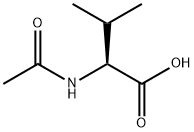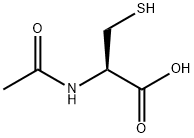N-Acetyl-L-proline
- CAS NO.:68-95-1
- Empirical Formula: C7H11NO3
- Molecular Weight: 157.17
- MDL number: MFCD00020837
- EINECS: 200-698-9
- SAFETY DATA SHEET (SDS)
- Update Date: 2025-12-17 09:49:18

What is N-Acetyl-L-proline?
Chemical properties
white to off-white powder
The Uses of N-Acetyl-L-proline
N-Acetyl-L-proline is an aminoacid used in the synthesis of pharmaceutical compounds useful in preventing and treating disorders and syndromes associated with the nervous, vascular, musculoskeletal, o r cutaneous systems.
Definition
ChEBI: N-acetyl-L-proline is a N-acetyl-L-amino acid, a N-acylpyrrolidine, a pyrrolidinemonocarboxylic acid and a L-proline derivative.
Biochem/physiol Actions
N-acetyl-L-proline is an analog of the COOH-terminal dipeptide portion of preferred substrates of angiotensin-converting enzyme (ACE). It may be used in studies of the binding of substrates and inhibitors by ACE and to differentiate the specificities of various aminoacylases.
References
[1] Jingxuan Qiu. “Solubility Behavior and Polymorphism of N-Acetyl-l-proline in 16 Individual Solvents from 283.15 to 323.15 K.” Journal of Chemical & Engineering Data 66 3 (2021): 1533–1542.
Description
N-Acetyl-L-proline (NALP) is an N-acetyl derivative of L-proline, which has wide application in medicine and is commonly utilized as a biologically active supplement. It can also act as an intermediate for synthesizing pharmaceuticals for preventing and treating some disorders and syndromes associated with the nervous, vascular, musculoskeletal, or cutaneous systems. In laboratories, it could play the role of a simple model for the secondary structure of proline-containing peptides. NALP can be acetylated from L-proline via a standard method, in the environment of acetic acid, or by the action of acetic anhydride on aqueous solutions of the products of the alkaline hydrolysis of gelatin followed by extraction. However, these methods may result in the production of many byproducts[1].
Properties of N-Acetyl-L-proline
| Melting point: | 115-117 °C |
| Boiling point: | 366.2±35.0 °C(Predicted) |
| alpha | -86 º (c=1 EtOH) |
| Density | 1.274±0.06 g/cm3(Predicted) |
| storage temp. | 2-8°C |
| solubility | Chloroform (Slightly), Methanol (Slightly), Water (Slightly) |
| form | Powder |
| pka | 3.69±0.20(Predicted) |
| color | White to off-white |
| BRN | 83200 |
| InChI | InChI=1S/C7H11NO3/c1-5(9)8-4-2-3-6(8)7(10)11/h6H,2-4H2,1H3,(H,10,11)/t6-/m0/s1 |
| CAS DataBase Reference | 68-95-1(CAS DataBase Reference) |
| NIST Chemistry Reference | L-proline, 1-acetyl-(68-95-1) |
Safety information for N-Acetyl-L-proline
| Signal word | Warning |
| Pictogram(s) |
 Exclamation Mark Irritant GHS07 |
| GHS Hazard Statements |
H302:Acute toxicity,oral H315:Skin corrosion/irritation H319:Serious eye damage/eye irritation H335:Specific target organ toxicity, single exposure;Respiratory tract irritation |
| Precautionary Statement Codes |
P261:Avoid breathing dust/fume/gas/mist/vapours/spray. P280:Wear protective gloves/protective clothing/eye protection/face protection. P301+P312:IF SWALLOWED: call a POISON CENTER or doctor/physician IF you feel unwell. P302+P352:IF ON SKIN: wash with plenty of soap and water. P305+P351+P338:IF IN EYES: Rinse cautiously with water for several minutes. Remove contact lenses, if present and easy to do. Continuerinsing. |
Computed Descriptors for N-Acetyl-L-proline
| InChIKey | GNMSLDIYJOSUSW-LURJTMIESA-N |
| SMILES | C(O)(=O)[C@@H]1CCCN1C(C)=O |
N-Acetyl-L-proline manufacturer
ALS India Life Sciences Pvt. Ltd
New Products
4,4-Difluoropiperidine hydrochloride tert-butyl 9-methoxy-3-azaspiro[5.5]undecane-3-carboxylate Indole Methyl Resin N-Isopropylurea N,N-Dicyclohexylcarbodiimide(DCC) MELDRUMS ACID 5-METHYLISOXAZOLE-4-CARBOXYLIC ACID Magnessium Bis glycinate Zinc ascorbate 1-bromo-2-butyne 2-acetamidophenol 9(10H)-anthracenone Erythrosin B, 4-Piperidinopiperidine 2-((4-morpholinophenylamino) (methylthio) methylene) malononitrile 2,4-dihydroxybenzaldehyde 3-(4-morpholinophenylamino)-5-amino-1H-pyrazole-4-carbonitrile Methyl 2-methylquinoline-6-carboxylate 2,6-dichloro-4-nitropyridine 4-Bromo-2-chlorobenzonitrile 2-(benzylamino)acetic acid hydrochloride 4-(tert-Butoxycarbonylamino)but- 2-ynoic acid 3,4-dihydro-2H-benzo[b][1,4]dioxepine 1-Phenyl-1-cycloprppanecarboxylicacidRelated products of tetrahydrofuran








You may like
-
 68-95-1 N-Acetyl-L-proline, 98% 98%View Details
68-95-1 N-Acetyl-L-proline, 98% 98%View Details
68-95-1 -
 68-95-1 95%View Details
68-95-1 95%View Details
68-95-1 -
 68-95-1 98%View Details
68-95-1 98%View Details
68-95-1 -
 N-Acetyl-L-proline, 95% 99%View Details
N-Acetyl-L-proline, 95% 99%View Details
68-95-1 -
 N-Acetyl-L-Proline extrapure CAS 68-95-1View Details
N-Acetyl-L-Proline extrapure CAS 68-95-1View Details
68-95-1 -
 N-Acetyl-L-proline 97% CAS 68-95-1View Details
N-Acetyl-L-proline 97% CAS 68-95-1View Details
68-95-1 -
 N-Acetyl-L-proline CAS 68-95-1View Details
N-Acetyl-L-proline CAS 68-95-1View Details
68-95-1 -
 N-Acetyl-L-proline 99.00%View Details
N-Acetyl-L-proline 99.00%View Details
68-95-1
